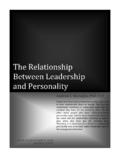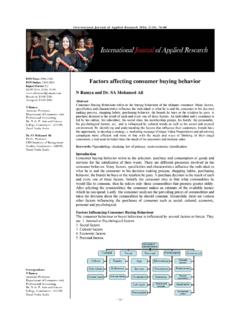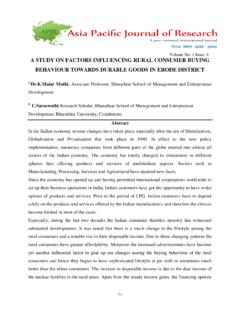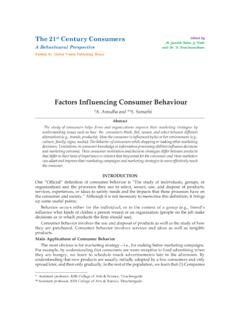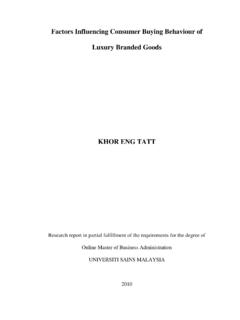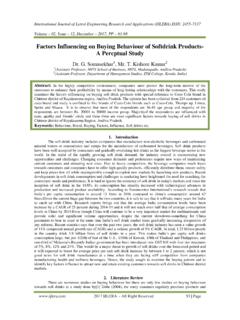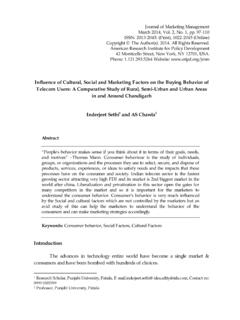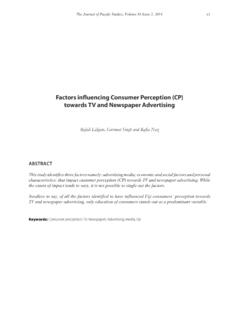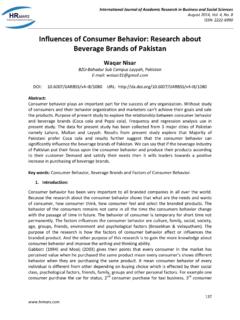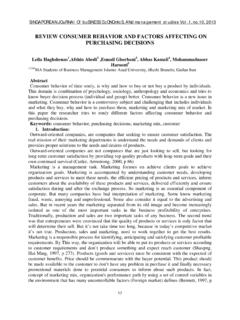Transcription of CULTURAL EFFECTS ON CONSUMER BEHAVIOR - lead …
1 CULTURAL EFFECTS ON CONSUMER BEHAVIOR w w w . l e a d-i n s p i r e . c o m D e c e m b e r 2 6 , 2 0 1 0 Andrew J. Marsiglia, PhD, CCP CULTURAL value systems have a direct effect on CONSUMER BEHAVIOR and vary by the major CULTURAL dimensions between countries but become increasingly complex when people immigrate to foreign countries that have different CULTURAL dimensions. In these situations, people are subjected to a wide variety of CULTURAL reference groups that ultimately affect their CONSUMER BEHAVIOR . Consequently, marketers must develop marketing communication that addresses CULTURAL and reference group factors from both a domestic and global perspective; that means marketers must adhere to the Levi-Strauss maxim to think globally but act locally.
2 To this end, marketers use market segmentation and micromarketing to develop customer-centric marketing messages with the goal of providing precisely defined marketing messages that satisfy CONSUMER s need for personal information regarding products and services so that consumers should be adequately stimulated to purchase the product or service being advertised. i Table of Contents Introduction .. 3 EFFECTS of CULTURAL Values on CONSUMER 3 Characteristics of CULTURAL Values .. 3 Strategic Application of Cross CULTURAL and Global Influence .. 5 Societal Implications of Reference Group Influences .. 6 Influence of Reference Groups on Consumers.
3 6 Strategic Application of Reference Group Influences .. 8 Nature of Reference Groups and Web Communities .. 9 Role of Households in Decision Making and Marketing Strategies .. 11 Purchasing Patterns by Household Life Cycles .. 11 Parent verses Peer Group Influence among Adolescents .. 13 Societal Implications of Household Influences .. 14 Merits and Demerits of Word-of-Mouth Communication .. 14 The Nature of Word-of-Mouth 14 Strategic Application of Word-of-Mouth 15 Strategic Application of Diffusion Theory.. 18 Market Segmentation and the Marketing Communication Process .. 19 Market Segmentation and Micromarketing .. 19 Marketing Communication 20 ii References .. 22 3 CULTURAL EFFECTS on CONSUMER BEHAVIOR Andrew J.
4 Marsiglia, PhD, CCP Introduction CONSUMER BEHAVIOR is largely dependent on CULTURAL factors consisting of mutually shared operating procedures, unstated assumptions, tools, norms, values, standards for perceiving, believing, evaluating, and communicating. CULTURAL factors vary by country but become increasingly complex when people immigrate to foreign countries that have different CULTURAL dimensions. In these situations, people are subjected to a wide variety of CULTURAL reference groups that ultimately affect their purchase BEHAVIOR . In addition, reference groups may consist of familial groups or external peer groups with each group providing specific and often conflicting information that affects purchase and consumption BEHAVIOR .
5 In response, marketers must develop marketing communication that addresses CULTURAL and reference group factors from both a domestic and global perspective. To this end, marketers use market segmentation and micromarketing to develop customer-centric marketing messages with the goal of providing precisely defined marketing messages that satisfy CONSUMER s need for personal information regarding products and services so that consumers should be adequately stimulated to purchase the product or service being advertised. EFFECTS of CULTURAL Values on CONSUMER BEHAVIOR Characteristics of CULTURAL Values Hofstede (1984) defines culture as, The collective programming of the mind which distinguishes the members of one human group from another p.
6 21. The elements of culture consist of mutually shared operating procedures, unstated assumptions, tools, norms, values, CULTURAL EFFECTS on CONSUMER BEHAVIOR , 4 4 habits about sampling the environment, etc. (Cross- CULTURAL Psychology, Encyclopedia of Applied Psychology) The element of value may be considered to include the concept of individuality, independence, achievement, and self-fulfillment. Hofstede (1984) indicates that value concepts that could have significant effect on CONSUMER BEHAVIOR . These value concepts may be defined as follows: A. Power-Distance (PD): Striving to have power over less powerful individuals and increasing the social distance between powerful and less powerful.
7 PD represents the degree of authoritarianism in a culture. B. Uncertainty Avoidance (UA): The level of anxiety about the future in a society and the corresponding need to protect society through technology, rules, and rituals. Low UA societies are more modern, pragmatic, and relativistic than high UA societies. High UA societies are more impoverished and ritualistic than low UA societies. C. Individualism (IDV): The relationship between the individual and the collective that prevails in a society. In high IDV countries, identity is based in the individual whereas in a low IDV country identity is based on the social system. Individuals tend to make decisions based on the proclivities of the group.
8 D. Masculinity (MAS): Male BEHAVIOR is associated with autonomy, aggression, exhibition, and dominance; female BEHAVIOR with nurturance, affiliation, helpfulness, and humility. High MAS societies are wealth oriented while low MAS societies are people oriented. In high MAS societies sex roles should be clearly differentiated while in low MAS societies sex roles should be fluid. CULTURAL EFFECTS on CONSUMER BEHAVIOR , 5 5 Strategic Application of Cross CULTURAL and Global Influence Research has shown that the strength of ethnic culture has a significant effect on CONSUMER purchasing BEHAVIOR and that the higher their strength of ethnic identification the greater their propensity to purchase products associated with their culture (Chattaraman, 2008).
9 Evidence, however, indicates that the longer consumers are in a host country the more likely the CONSUMER will adopt CULTURAL values specific to the host country. This acculturation becomes complex when the CONSUMER is in close contacts with other unique ethnic cultures, especially in the United States, resulting in a cross- CULTURAL amalgam (Ogden, 2004), (Chattaraman, 2008). The results of these studies suggest that the micro-segmentation of consumers according to their CULTURAL values would be important for marketing managers operating in heterogeneous, multicultural markets such as the (Daghfous, 1999). There is evidence that ethnic influences affect purchases to the degree that consumers tend to acculturate to the host country, creating a cross CULTURAL condition in the process (Chattaraman, 2008).
10 The marketing message, therefore, must address the CULTURAL characteristics that correspond to the level of acculturation. For instance, if an ethnic CONSUMER group strongly resists assimilation into the host country s culture, such as some Hispanic groups in the , the marketing message would focus on the characteristics of the Hispanic host country per the culture value dimensions posited by Hofstede (1984). As a foreigner becomes acculturated to the host country, the marketing message would be moderated to include messages that combine CULTURAL characteristics of the host country and the country of origin. In countries other than the , an effective marketing message would need to address the CULTURAL values of the particular ethnic group in question relative to the CULTURAL dimensions of the host country (Ogden, 2004; Hofstede, 1984).
